 W
WThe 2nd Spanish Armada also known as the Spanish Armada of 1596 was a naval operation that took place during the Anglo–Spanish War. Another invasion of England or Ireland was attempted in the autumn of 1596 by King Philip II of Spain. In an attempt at revenge for the English sack of Cadiz in 1596, Philip immediately ordered a counter strike in the hope of assisting the Irish rebels in rebellion against the English crown. The strategy was to open a new front in the war, forcing English troops away from France and the Netherlands, where they were also fighting.
 W
WThe 3rd Spanish Armada, also known as the Spanish Armada of 1597, was a major naval event that took place between October and November 1597 as part of the Anglo–Spanish War. The armada, which was the third attempt by Spain to invade or raid the British Isles during the war, was ordered by King Philip II of Spain in revenge for the English attack on Cadiz following the failure of the 2nd Spanish Armada the previous year due to a storm. The Armada was executed by the Adelantado, Martín de Padilla, who was hoping to intercept and destroy the English fleet under Robert Devereux the 2nd Earl of Essex as it returned from the failed Azores expedition. When this was achieved, the Armada would go on to capture either the important port of Falmouth or Milford Haven and use those places as a base for invasion.
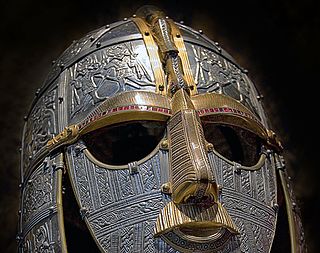 W
WThe Anglo-Saxon settlement of Britain is the process which changed the language and culture of most of what became England from Romano-British to Germanic. The Germanic-speakers in Britain, themselves of diverse origins, eventually developed a common cultural identity as Anglo-Saxons. This process principally occurred from the mid-fifth to early seventh centuries, following the end of Roman rule in Britain around the year 410. The settlement was followed by the establishment of the Heptarchy, Anglo-Saxon kingdoms in the south and east of Britain, later followed by the rest of modern England, and the south-east of modern Scotland.
 W
WThe Battle of Dorking: Reminiscences of a Volunteer is an 1871 novella by George Tomkyns Chesney, starting the genre of invasion literature and an important precursor of science fiction. Written just after the Prussian victory in the Franco-Prussian War, it describes an invasion of Britain by a German-speaking country referred to in oblique terms as The Other Power or The Enemy.
 W
WThe Battle of Landguard Fort or the Attack on Landguard Fort was a battle towards the end of the Second Anglo-Dutch War on 2 July 1667 where a Dutch force attacked Landguard Fort near Felixstowe. It was intended to clear the way for an attack on the English Royal naval anchorage at Harwich. After repeated attempts the Dutch attack planned by Michiel de Ruyter was repelled and as a result the planned attack on Harwich was abandoned. It was one of the last battles of the war in Europe before the Treaty of Breda was signed.
 W
WIn the autumn of 1016, the Danish prince Cnut the Great (Canute) successfully invaded England. Cnut's father, Sweyn Forkbeard, had previously conquered and briefly ruled England for less than five weeks.
 W
WThe Danelaw was the part of England in which the laws of the Danes held sway and dominated those of the Anglo-Saxons. The Danelaw contrasts with the West Saxon law and the Mercian law. The term is first recorded in the early 11th century as Dena lage. The areas that constituted the Danelaw lie in northern and eastern England, long occupied by Danes and other Norsemen.
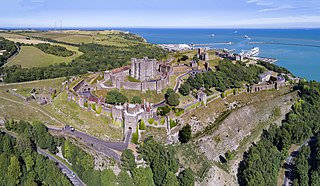 W
WDover Castle is a medieval castle in Dover, Kent, England. It was founded in the 11th century and has been described as the "Key to England" due to its defensive significance throughout history. Some sources say it is the largest castle in England, a title also claimed by Windsor Castle.
 W
WEngland Invaded is a collection of imaginative fiction, including invasion literature, from the Victorian and Edwardian periods, edited by British author Michael Moorcock. Originally published in hardback by W. H. Allen in 1977, it was re-issued as a paperback by Star in 1980.
 W
WThe invasion of England in 1326 by the country's queen, Isabella of France, and her lover, Roger Mortimer, led to the capture of Hugh Despenser the Younger and the abdication of Isabella's husband, King Edward II. It brought an end to the insurrection and civil war.
 W
WThe First Barons' War (1215–1217) was a civil war in the Kingdom of England in which a group of rebellious major landowners led by Robert Fitzwalter waged war against King John of England. The conflict resulted from King John's disastrous wars against King Philip II of France, which led to the collapse of the Angevin Empire, and John's subsequent refusal to accept and abide the "Magna Carta", which he had sealed on 15 June 1215.
 W
WThe Battle of Flodden, Flodden Field, or occasionally Branxton, was a battle fought on 9 September 1513 during the War of the League of Cambrai between the Kingdom of England and the Kingdom of Scotland, resulting in an English victory. The battle was fought near Branxton in the county of Northumberland in northern England, between an invading Scots army under King James IV and an English army commanded by the Earl of Surrey. In terms of troop numbers, it was the largest battle fought between the two kingdoms.
 W
WThe Glorious Revolution of November 1688, also known as the Glorieuze Overtocht or Glorious Crossing by the Dutch, was the deposition of James II and VII, king of England, Scotland and Ireland and replacement by his daughter Mary II and her husband, William III of Orange, stadtholder and de facto ruler of the Dutch Republic. A term first used by John Hampden in late 1689, historian Jeremy Black suggests it can be seen as both the last successful invasion of England and also an internal coup.
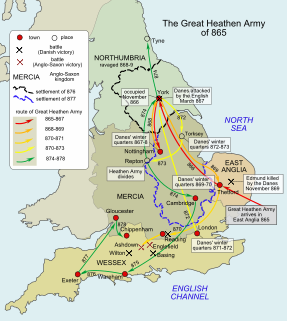 W
WThe Great Heathen Army, also known as the Viking Great Army, was a coalition of Scandinavian warriors mainly Danes, who invaded England in 865 AD. Since the late 8th century, the Vikings had been engaging in raids on centres of wealth such as monasteries. The Great Heathen Army was much larger and aimed to occupy and conquer the four kingdoms of East Anglia, Northumbria, Mercia and Wessex.
 W
WThe Great War in England in 1897 was written by William Le Queux and published in 1894.
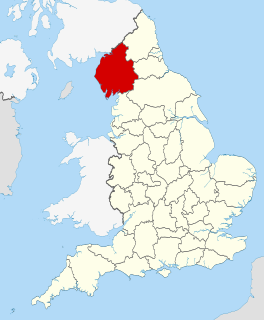 W
WThe history of Cumbria as a county of England begins with the Local Government Act 1972. Its territory and constituent parts however have a long history under various other administrative and historic units of governance. Cumbria is an upland, coastal and rural area, with a history of invasions, migration and settlement, as well as battles and skirmishes between the English and the Scots.
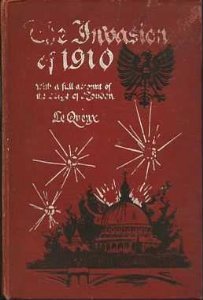 W
WThe Invasion of 1910 is a 1906 novel written mainly by William Le Queux. It is one of the most famous examples of invasion literature. It is viewed by some as an example of pre-World War I Germanophobia. It can also be viewed as prescient, as it preached the need to prepare for war with Germany.
 W
WThe French invasion of the Isle of Wight occurred during the Italian Wars in July 1545. The invasion was repulsed.
 W
WThe Jacobite rising of 1745, also known as the Forty-five Rebellion or simply the '45, was an attempt by Charles Edward Stuart to regain the British throne for his father, James Francis Edward Stuart. It took place during the War of the Austrian Succession, when the bulk of the British Army was fighting in mainland Europe, and proved to be the last in a series of revolts that began in 1689, with major outbreaks in 1708, 1715 and 1719.
 W
WJacobitism was a largely 17th- and 18th-century movement that supported the restoration of the senior line of the House of Stuart to the British throne. The name is derived from Jacobus, the Latin version of James.
 W
WThis is a list of the members of the British nobility and gentry, who in 1688 deserted King James II and pledged their allegiances to Prince William of Orange, as the events of the Glorious Revolution unfolded.Admiral Matthew Aylmer, who played a significant role in diverting the loyalty of the Royal Navy from King James to William of Orange. Colonel Berkley, possibly Lord Fitzharding. Captain Henry Bertie, brother of the Earl of Abingdon. Squire Bray Henry Booth, 2nd Baron Delamere, took arms in Cheshire on November 1688, appearing in Manchester with 50 armed and mounted men, which had trebled before reaching Bowden Downs. James Butler, 2nd Duke of Ormonde William Cavendish, 4th Earl of Devonshire, appeared in arms at Derby, proceeded to Nottingham, which soon became the headquarters of the Northern insurrection. John Cecil, 5th Earl of Exeter Hugh Cholmondeley, 2nd Viscount Cholmondeley, joined the northern insurrection at Nottingham in 1688, created Baron in 1689 and Earl in 1706. Charles Cokayne, 3rd Viscount Cullen Squire Coote George Compton, 4th Earl of Northampton Henry Compton, youngest son of the 2nd Earl of Northampton, Bishop of London, P.C. George Churchill (1653–1710), brother of John Churchill and captain at sea, afterwards admiral. John Churchill, Baron Churchill of Sandridge (1650–1722), deserted on 25 Nov 1688, arguably "the death-blow for the Royal Cause". Afterwards created Earl and later Duke of Marlborough and captain-general. Sir Richard Dutton, or possibly Sir Ralph Dutton, MP for Gloucester Thomas Fairfax, 5th Lord Fairfax of Cameron, MP for York. Charles Fane, 3rd Earl of Westmorland Henry FitzRoy, 1st Duke of Grafton, the first who on 24 November 1688 deserted the King's camp, accompanied by John Churchill. Charles Gerard, 1st Earl of Macclesfield, an "ancient Cavalier who had fought for Charles I, and had shared the exile of Charles II", assembled with William at the Hague in 1688. John Granville, 1st Earl of Bath, placed the fortress at Plymouth, which he commanded, at William's disposal on 18 November 1688, when William had arrived at Exeter. "The invaders therefore had now not a single enemy in their rear." Thomas Grey, 2nd Earl of Stamford Captain Griffith Sir John Guise, Baronet, MP for Gloucester Henry Hamilton-Moore, 3rd Earl of Drogheda Sir Edward Harley, Baronet, in November 1688 took up arms in Worcestershire on behalf of the Prince of Orange. Arthur Herbert, vice admiral, created Earl of Torrington in 1689. Henry Herbert, 4th Baron Herbert of Cherbury, in November 1688 took up arms in Worcestershire on behalf of the Prince of Orange. Henry Howard, 7th Duke of Norfolk, with 300 armed and mounted men, in November 1688 appeared in the market place of Norwich, where he was joined by the mayor and Alderman. Edward Hyde, Lord Cornbury (1661–1723), son of the Earl of Clarendon and one of the first royal commanders to desert. He was the senior officer at Salisbury and deserted with as many troops as he could induce to follow him. Henry Hyde, 2nd Earl of Clarendon (1638–1709), father of Lord Cornbury Robert Leke, 3rd Earl of Scarsdale John Lovelace, 3rd Baron Lovelace, set out for Exeter to join the Prince of Orange, but was taken prisoner at Gloucester. Richard Lumley seized Newcastle for William, created Viscount Lumley in 1689 and Earl of Scarborough in 1690. John Manners, 9th Earl of Rutland Squire Marle Charles Montagu, 4th Earl of Manchester, moved to Nottingham and was joined by Lord Cholmondeley and by Lord Grey de Ruthyn. Edward Osborne, Viscount Latimer, son the Earl of Danby. Peregrine Osborne, Lord Dunblane, son the Earl of Danby. Thomas Osborne, 1st Earl of Danby (1631–1712), seized York for William, was created Duke of Leeds in 1694. James Paynter, tried for and later acquitted of treason in Cornwall. Sir Robert Peyton, Baronet, colonel in the Dutch invasion Charles Powlett, Earl of Wiltshire Charles Bodvile Robartes, 2nd Earl of Radnor Richard Savage, Lord Colchester, son of Earl Rivers Charles Seymour, 6th Duke of Somerset Robert Shirley, Lord Ferrers of Chartley Philip Stanhope, 2nd Earl of Chesterfield Charles Talbot, 12th Earl of Shrewsbury Squire Tibbing, probably Squire Thomas Tipping (1653–1718), former MP for Oxfordshire who had fled to the Netherlands due to a scandal Sir John Trelawney, possibly Sir Jonathan Trelawny, 3rd Baronet Squire Trenchard (1635–1713), possibly William Trenchard of Cutteridge, Wiltshire Henry Yelverton, 15th Baron Grey de Ruthyn, joined the Northern insurrection in 1688, created Viscount de Longueville in 1690.
 W
WLundy is an English island in the Bristol Channel. It forms part of the district of Torridge in the county of Devon.
 W
WThe Raid on the Medway, during the Second Anglo-Dutch War in June 1667, was a successful attack conducted by the Dutch navy on English warships laid up in the fleet anchorages off Chatham Dockyard and Gillingham in the county of Kent. At the time, the fortress of Upnor Castle and a barrier chain called the "Gillingham Line" were supposed to protect the English ships.
 W
WPrehistoric Cumbria describes that part of north-west England, subsequently the county of Cumbria, prior to the coming of the Romans. Barrowclough puts the archaeological record of the county at '443 stone tools, 187 metal objects and 134 pots', plus the various monuments such as henges, stone circles, and the like. The survival of these objects has been influenced by processes such as the rise in sea levels on the west coast, erosion, deposition practices, industrial and agricultural development, and the changing interests and capabilities of antiquarians and archaeologists.
 W
WThe Raid on Mounts Bay also known as the Spanish attack on Mounts Bay was a Spanish raid on Cornwall, England, that took place between 2 and 4 August 1595 during the Anglo-Spanish war of 1585-1604. It was conducted by a Spanish naval squadron led by Carlos de Amésquita on patrol from Brittany, France. The Spanish made landfall in Mount's Bay then sacked and burned Newlyn, Mousehole, Penzance, and Paul, beating a militia force under Francis Godolphin in the process.
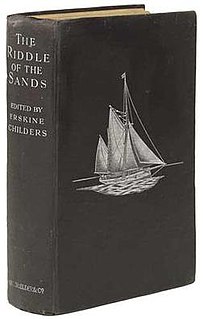 W
WThe Riddle of the Sands: A Record of Secret Service is a 1903 novel by Erskine Childers. The book, which enjoyed immense popularity in the years before World War I, is an early example of the espionage novel and was extremely influential in the genre of spy fiction. It has been made into feature-length films for both cinema and television.
 W
WThe Roman conquest of Britain was a process that consisted of the conquest of territory located on the island of Britain by occupying Roman forces. It began in AD 43 under Emperor Claudius, and was largely completed by 87 when the Stanegate was established.
 W
WRoman Cumbria was an area that lay on the north-west frontier of Roman Britain, and, indeed, of the Roman Empire itself.. Interest in the Roman occupation of the region lies in this frontier aspect - why did the Romans choose to occupy the north-west of England; why build a solid barrier in the north of the region ; why was the region so heavily militarised; to what extent were the native inhabitants 'Romanised' compared to their compatriots in southern England?
 W
WOperation Sea Lion, also written as Operation Sealion, was Nazi Germany's code name for the plan for an invasion of the United Kingdom during the Battle of Britain in the Second World War. Following the Fall of France, Adolf Hitler, the German Führer and Supreme Commander of the Armed Forces, hoped the British government would accept his offer to end the war, and he reluctantly considered invasion only as a last resort if all other options failed.
 W
WShingle Street is a coastal settlement on the North Sea coast of the English county of Suffolk. It is 8 miles (13 km) north-east of Felixstowe and 12 miles (19 km) east of Ipswich at the mouth of the River Ore and opposite the tip of Orford Ness. It is within the parish of Hollesley with HM Young Offender Institution Hollesley Bay Colony nearby.
 W
WThe First Siege of Carlisle was an important event of the 1745–1746 Jacobite rising. Jacobite forces loyal to Prince Charles Edward Stuart captured the city of Carlisle and Carlisle Castle on 14–15 November 1745.
 W
WThe Spanish Armada was a Habsburg Spanish fleet of 130 ships that sailed from Lisbon in late May 1588 under the command of the Duke of Medina Sidonia, with the purpose of escorting an army from Flanders to invade England. Medina Sidonia was an aristocrat without naval command experience but was made commander by King Philip II. The aim was to overthrow Queen Elizabeth I and her establishment of Protestantism in England, to stop English interference in the Spanish Netherlands, and to stop the harm caused by English and Dutch privateering ships that disrupted Spanish interests in the Americas.
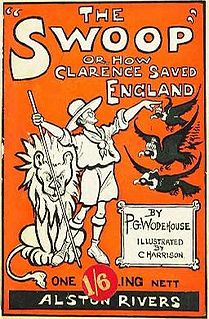 W
WThe Swoop!, or How Clarence Saved England is a short comic novel by P. G. Wodehouse, first published in the United Kingdom by Alston Rivers Ltd, London, on 16 April 1909. Its subtitle is A Tale of the Great Invasion.An adapted and much abbreviated version, set in the United States, appeared in the July and August 1915 issues of Vanity Fair under the title The Military Invasion of America and with the subtitle A Remarkable Tale of the German-Japanese Invasion of 1916.The original story was not published in the United States until 1979, four years after Wodehouse's death, when it was included in the collection The Swoop! and Other Stories.The opening sentences of chapter 4 include: "But first the Territorials dropped out. The strain of being referred to on the music-hall stage as Teddy boy's was too much for them.". Although this was a reference to King Edward VII, in whose service they were, and not the 1950's British youth subculture, it is, none-the-less, the earliest documented use of the description.
 W
WTeignmouth is a seaside town, fishing port and civil parish in the English county of Devon. It is situated on the north bank of the estuary mouth of the River Teign, about 12 miles south of Exeter. The town had a population of 14,749 at the last census in 2011.
 W
WWent the Day Well? is a 1942 British war film adapted from a story by Graham Greene and directed by Alberto Cavalcanti. It was produced by Michael Balcon of Ealing Studios and served as unofficial propaganda for the war effort. It tells of how an English village is taken over by German paratroopers. It reflects the greatest potential nightmare of many Britons of the time, although the threat of German invasion had largely receded by that point.